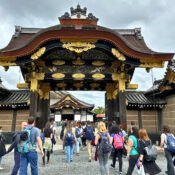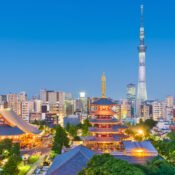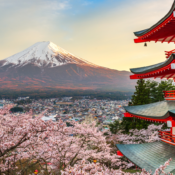7 Days in Tokyo Itinerary: The Ultimate Travel Guide for First-Time Visitors
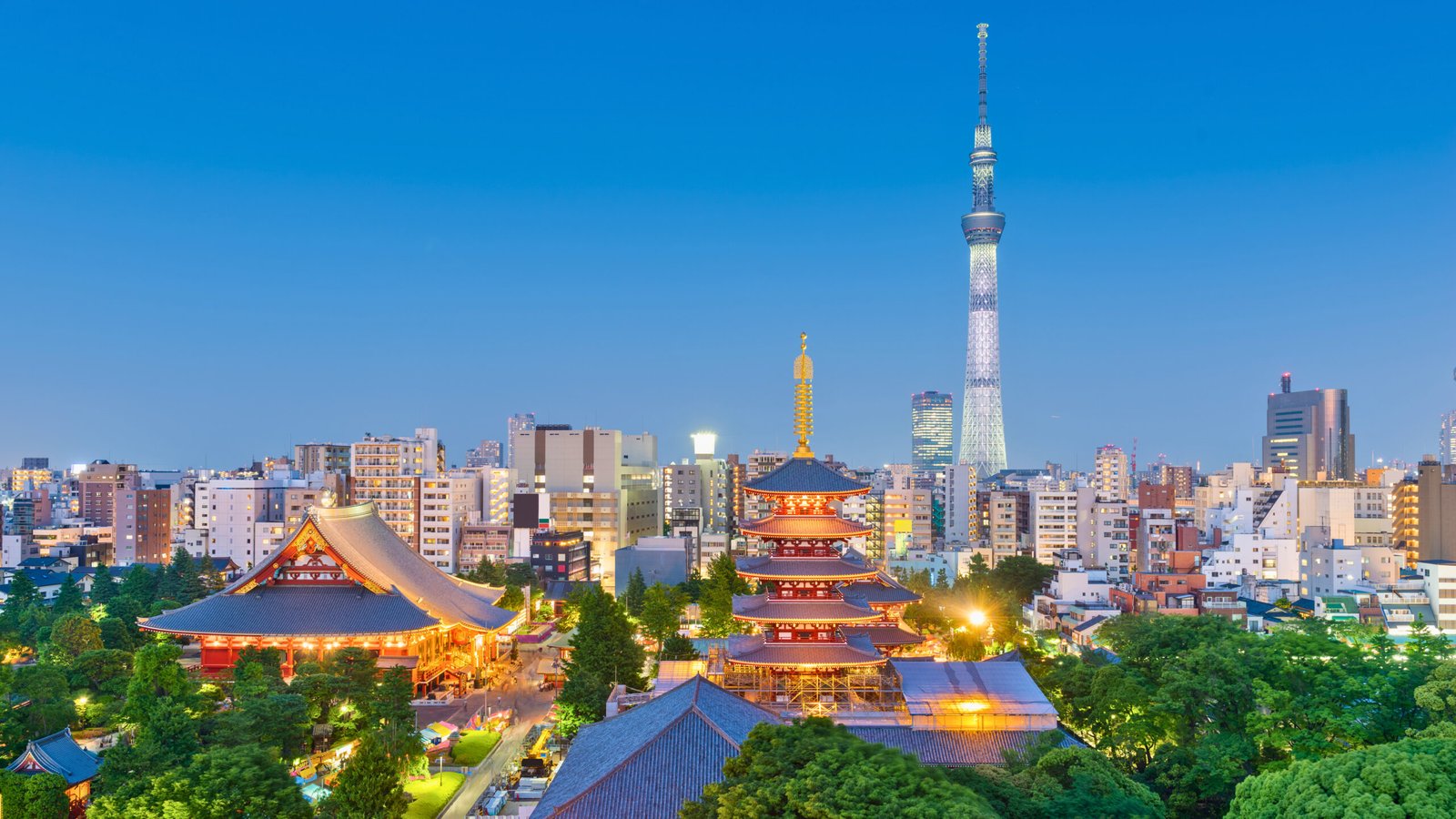
7 Days in Tokyo Itinerary: The Ultimate Travel Guide for First-Time Visitors
Tokyo, a city where ancient traditions blend seamlessly with cutting-edge modernity, is a dream destination for travelers and one of the best places to visit in Japan. Planning a detailed itinerary can be overwhelming if it’s your first time visiting this vibrant metropolis. But don’t worry! This 7 days in Tokyo itinerary has you covered. From iconic landmarks to hidden gems, local food to cultural experiences, here’s everything you need for an unforgettable week in Tokyo.
Imagine wandering through bustling streets lined with neon signs, savoring the aroma of freshly made ramen from tiny alleyway shops, and experiencing the serenity of ancient temples tucked within lush green parks. Tokyo is a city of contrasts where every corner holds a story, and every experience feels unique. Whether you’re a history buff, a foodie, a tech enthusiast, or an art lover, this city has something to captivate your heart.
Check out our YouTube video about Japan, which takes you through Japan’s top destinations you must go.

Table of Contents
Day 1: Arrival and Exploring Shinjuku
Welcome to Tokyo! Your first day is all about settling in and getting a feel for the city’s energy. Start your adventure in Shinjuku, one of Tokyo’s most vibrant districts, where dazzling lights, lush gardens, and bustling streets set the stage for an unforgettable trip. From serene parks to neon-lit nightlife, your Tokyo journey begins with a perfect mix of excitement and relaxation.
Morning: Arrival and Check-In
After a long flight, arriving in Tokyo is an exciting moment. Whether you land at Narita or Haneda Airport, the city’s efficient train systems make it easy to reach your accommodation. If you’re staying in Shinjuku, you’re perfectly positioned to explore one of Tokyo’s most vibrant districts. Popular hotels like the Keio Plaza Hotel or Hotel Gracery Shinjuku offer excellent amenities and convenient locations.
Once you’ve settled in, take some time to rest and recharge. For those eager to start exploring, grab a Suica or Pasmo card—rechargeable smart cards that make navigating Tokyo’s public transportation a breeze.
Afternoon: Shinjuku Gyoen National Garden
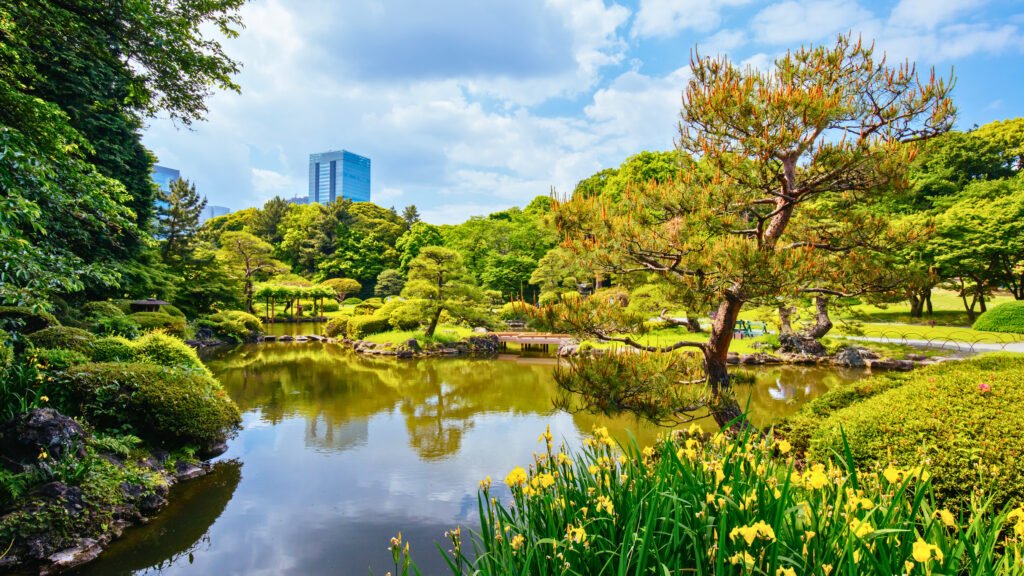
Kick off your Tokyo adventure with a visit to Shinjuku Gyoen National Garden, a serene oasis amidst the city’s hustle and bustle. This sprawling park combines Japanese, English, and French garden styles, offering a peaceful retreat where you can admire seasonal flowers, koi ponds, and manicured landscapes. It’s an incredibly stunning spot during cherry blossom season in spring or when the leaves change in autumn.
Stroll through the park at your own pace, admire the beauty of the traditional teahouse, and snap some photos to commemorate your first day in Tokyo.
Evening: Kabukicho and Omoide Yokocho
As night falls, head to Kabukicho, Tokyo’s famous entertainment and nightlife district. Neon lights and bustling crowds create an electric atmosphere. While Kabukicho is known for its nightlife, there are plenty of family-friendly restaurants and entertainment options.
For a more traditional experience, visit Omoide Yokocho (“Memory Lane”), a narrow alleyway lined with tiny eateries serving yakitori (grilled chicken skewers), ramen, and other Japanese delicacies. Its retro vibe and cozy atmosphere make it the perfect place to end your first day in Tokyo.
Day 2: Cultural Immersion in Asakusa and Ueno
Today, you’ll step back in time to experience Tokyo’s rich history and cultural heritage. Begin your journey at Senso-ji Temple in Asakusa, the city’s most famous Buddhist temple, before exploring the lush landscapes of Ueno Park. This day is all about tradition, spirituality, and discovering the cultural heartbeat of Tokyo.
Morning: Senso-ji Temple
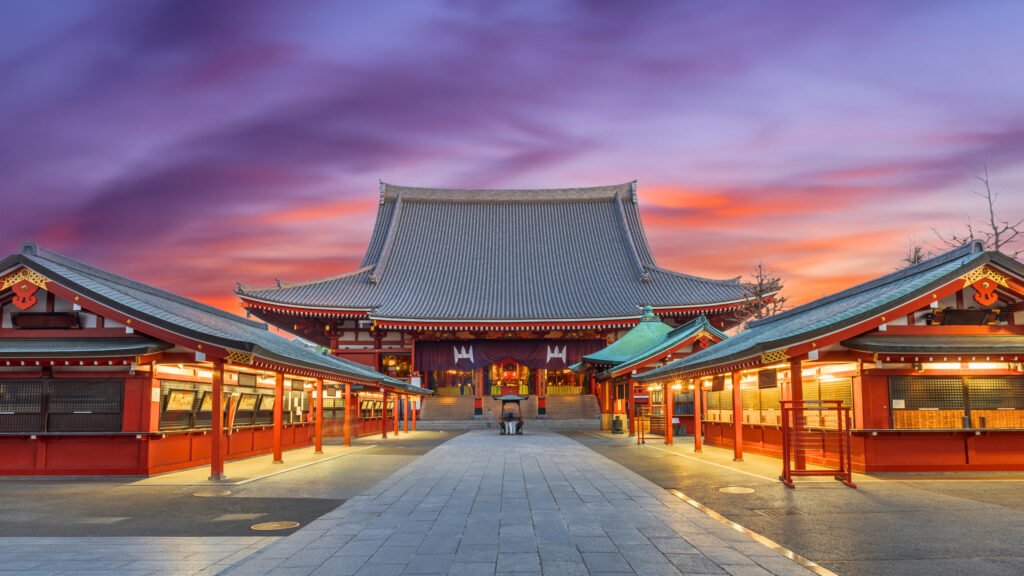
Start your second day with a visit to Senso-ji, Tokyo’s oldest and most iconic temple. Located in the historic district of Asakusa, the temple is dedicated to Kannon, the Buddhist goddess of mercy. Enter through the majestic Kaminarimon Gate, adorned with its massive red lantern, and walk along Nakamise Street, a bustling shopping avenue filled with stalls selling souvenirs, traditional snacks, and street food.
At the temple, take part in traditional rituals, such as wafting incense smoke for good health or drawing omikuji (fortune-telling paper slips). The temple grounds are lively and full of cultural charm, offering a perfect introduction to Tokyo’s spiritual heritage.
Afternoon: Ueno Park and Tokyo National Museum
A short train ride from Asakusa brings you to Ueno, home to one of Tokyo’s largest parks. Ueno Park is a cultural hub featuring museums, a zoo, and beautiful walking paths. The park is one of the city’s top cherry blossom viewing spots in spring.
For history and art enthusiasts, the Tokyo National Museum is a must-visit. It houses an extensive collection of Japanese artifacts, including samurai armor, traditional pottery, and delicate kimonos. The museum’s elegant architecture and peaceful atmosphere make it a highlight of your day.
Evening: Ameya-Yokocho Market
End your day at Ameya-Yokocho, a vibrant market street near Ueno Station. Once a black market after World War II, this bustling area is now filled with shops and stalls selling everything from fresh produce to quirky souvenirs.
This is also a great spot to try Tokyo’s street food. Don’t miss takoyaki (octopus balls), taiyaki (fish-shaped pastries filled with sweet red bean paste or custard), and skewered meats. The lively atmosphere and endless variety make it a memorable evening destination.
Day 3: Modern Tokyo in Shibuya and Harajuku
From ancient traditions to the pulse of modern Tokyo, today’s itinerary takes you into the heart of the city’s youth culture and fashion scene. You’ll witness the organized chaos of Shibuya Crossing, explore the serene Meiji Shrine, and dive into the eccentric streets of Harajuku, where creativity knows no bounds.
Morning: Shibuya Crossing and Hachiko Statue
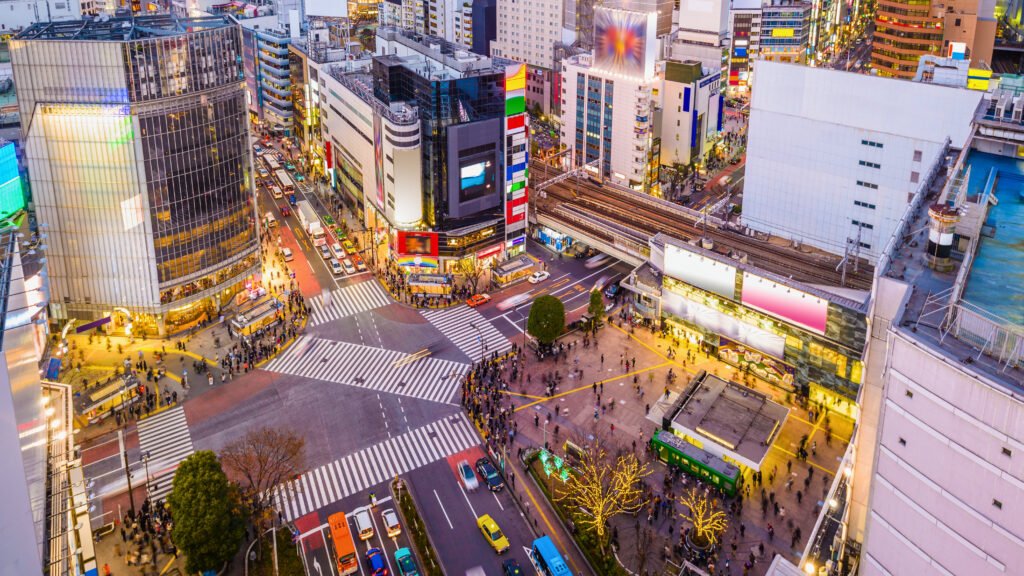
Day three begins at one of Tokyo’s most famous landmarks: Shibuya Crossing. Often called the busiest pedestrian intersection in the world, this iconic spot is a true spectacle of urban energy. Watching the synchronized flow of people from the surrounding buildings is a mesmerizing experience.
Nearby, you’ll find the Hachiko Statue, a heartwarming tribute to a loyal Akita dog. Hachiko’s story of waiting for his owner at Shibuya Station every day, even after his owner’s passing, has made him a symbol of devotion.
Afternoon: Meiji Shrine and Yoyogi Park
Next, head to Harajuku to visit Meiji Shrine, a Shinto sanctuary surrounded by a peaceful forest. Dedicated to Emperor Meiji and Empress Shoken, this sacred site offers a serene escape from the city. Don’t miss writing a wish on an ema (wooden prayer plaque) or observing a traditional wedding ceremony if you’re lucky.
After your visit, take a leisurely stroll through Yoyogi Park, a spacious green area popular with locals. It’s a great place for people-watching, picnics, or simply relaxing under the shade of the trees.
Evening: Takeshita Street
No visit to Harajuku is complete without exploring Takeshita Street. This lively pedestrian street is the epicenter of youth culture, known for its colorful shops, unique fashion, and Instagram-worthy cafes. Indulge in a Harajuku crepe, try some rainbow cotton candy, or shop for quirky souvenirs.
The energy of Takeshita Street makes it a perfect way to round out your day in modern Tokyo.
Day 4: Day Trip to Hakone
A trip to Tokyo isn’t complete without an excursion to Hakone, a scenic retreat known for its hot springs, traditional ryokans, and breathtaking views of Mount Fuji. Located just 90 minutes from Tokyo, Hakone offers a refreshing escape from the city’s fast-paced energy.
Morning: Journey to Hakone and Hakone Open-Air Museum
Start your day early to make the most of your trip. The best way to travel from Tokyo to Hakone is via the Odakyu Romancecar, a comfortable express train from Shinjuku Station to Hakone-Yumoto Station. Alternatively, you can take the Shinkansen (bullet train) from Tokyo Station to Odawara Station, followed by a local train or bus to Hakone.
To save money and enjoy unlimited travel within the region, purchase the Hakone Free Pass, which grants access to various transportation options, including buses, cable cars, and boats.
Upon arrival, head straight to the Hakone Open-Air Museum, an extraordinary outdoor art gallery set against the backdrop of lush mountains. The museum showcases contemporary sculptures from artists like Picasso and Henry Moore, along with interactive exhibits that blend art with nature. One of the highlights is the Symphonic Sculpture, a towering stained-glass cylinder that visitors can climb for panoramic views of the museum grounds.
Afternoon: Owakudani and Hakone Ropeway, Lake Ashi and Hakone Shrine, and Onsen (Hot Spring)
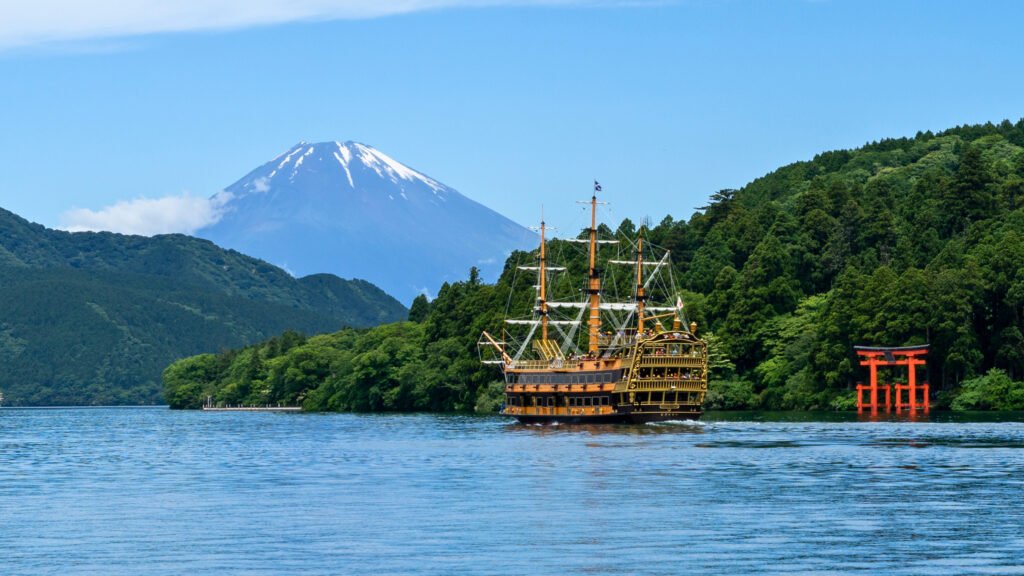
Next, take the Hakone Ropeway to Owakudani, an active volcanic valley known for its steaming vents and sulfuric hot springs. This dramatic landscape was formed during Mount Hakone’s last eruption over 3,000 years ago, and it remains one of the most fascinating sights in the area. While you’re here, be sure to try Kuro-Tamago (black eggs), which are boiled in the naturally sulfuric waters of the valley. If the weather is clear, you’ll be treated to breathtaking views of Mount Fuji from various points along the ropeway.
After exploring Owakudani, take the Hakone Sightseeing Cruise across Lake Ashi, a serene crater lake offering stunning views of Mount Fuji on clear days. The boat ride is a peaceful way to enjoy the natural beauty of Hakone, and it provides easy access to Hakone Shrine. Located at the edge of the lake, Hakone Shrine is one of Japan’s most picturesque Shinto shrines. Its famous red torii gate, standing partially submerged in the water, creates a stunning contrast against the backdrop of the lake and mountains.
No trip to Hakone is complete without a visit to an onsen (hot spring bath). The region is famous for its natural geothermal waters, which are rich in minerals and offer therapeutic benefits. For a traditional experience, consider staying at a ryokan (Japanese inn), such as Gora Kadan or Hakone Kowakien Tenyu, where you can enjoy private or public baths. If you’re on a day trip, there are several public bathhouses like Tenzan Onsen or Yunessun Spa Resort, where you can enjoy everything from traditional hot spring baths to unique themed baths like green tea and wine baths.
Evening: Return to Tokyo
After a full day of relaxation and exploration, take the Romancecar or Shinkansen back to Tokyo. Consider dining at a cozy izakaya in Shinjuku, where you can enjoy small plates of Japanese favorites like karaage (fried chicken), gyoza (dumplings), and edamame.
Day 5: Technology and Pop Culture in Akihabara
Akihabara, Tokyo’s electric town, is a paradise for anime lovers, tech enthusiasts, and gamers. Whether you want to browse the latest gadgets, hunt for rare collectibles, or immerse yourself in unique pop culture experiences, this district has something for everyone.
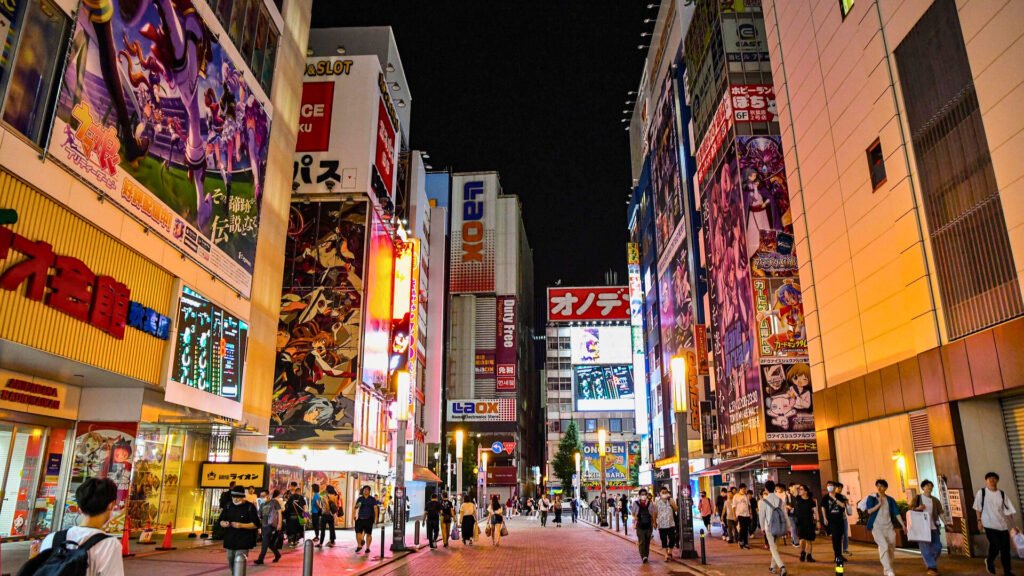
Morning: Akihabara’s Electronics and Anime Shops
Start your day exploring the Yodobashi Camera, a multi-story electronics store where you can find everything from the latest gadgets and cameras to home appliances and gaming consoles. Tech enthusiasts will appreciate the vast selection and knowledgeable staff ready to help.
For anime and manga lovers, Akihabara is heaven. Head to Mandarake, a massive second-hand store filled with rare manga, anime figurines, and collectibles. Another must-visit is Animate Akihabara, one of the biggest anime merchandise stores in Japan, where you can find posters, books, DVDs, and character goods.
If you’re into gaming, don’t miss Super Potato, a legendary retro gaming store packed with classic consoles, cartridges, and nostalgic arcade games from the golden era of gaming. Here, you can play vintage games and buy rare finds that aren’t available elsewhere.
Afternoon: Themed Cafés, teamLab Planets Tokyo, Akihabara Arcades and Shopping
No trip to Akihabara is complete without experiencing one of its famous themed cafés. Choose from:
- Maid Cafés: Enjoy a fun and quirky experience at Maidreamin or @Home Café, where waitresses dressed as maids serve food with playful interactions.
- Gundam Café: A must-visit for fans of the Gundam series, offering themed meals and exclusive merchandise.
- Animal Cafés: Spend some time relaxing at a cat, owl, or even hedgehog café for a unique Tokyo experience.
After lunch, take the train to teamLab Planets Tokyo, an interactive digital art museum that will leave you mesmerized. This immersive experience lets you walk through water, step into infinite mirror rooms, and interact with surreal light installations. The blend of technology and creativity makes this one of Tokyo’s must-see attractions.
Akihabara is famous for its multi-story arcades, where you can try your luck at crane games, rhythm games, and high-tech VR experiences. Head to SEGA Akihabara or Taito Station for a nostalgic yet futuristic gaming adventure. Whether you’re into claw machines, Dance Dance Revolution, or competitive fighting games, these arcades provide hours of entertainment.
If you’re still in the mood for shopping, explore Akihabara Radio Kaikan, a massive shopping complex filled with niche hobby stores selling rare anime figures, trading cards, and unique Japanese pop culture items. Even if you’re not buying, browsing through these shops is an experience in itself.
Evening: Dinner and Nightlife in Akihabara
For dinner, Akihabara offers a variety of dining experiences:
- Kanda Matsuya: A historic soba noodle restaurant serving handmade soba in a traditional setting.
- Gyukatsu Motomura: Known for its crispy, juicy beef cutlets, this spot is a favorite among visitors.
- Curry House CoCo Ichibanya: If you’re craving Japanese curry, this chain offers customizable spice levels and toppings.
If you’re up for something truly unique, consider dining at Robot Restaurant (located in nearby Shinjuku). This futuristic dinner show features flashing lights, dancing robots, and high-energy performances for an unforgettable night.
After dinner, if you still have energy left, explore Akihabara’s late-night anime and hobby stores, many of which remain open until midnight. Alternatively, take a relaxing stroll back to your hotel and prepare for another exciting day ahead.
Day 6: Serenity in Ginza and Tsukiji
Day 6 in Tokyo is all about enjoying a more refined, relaxed experience. From high-end shopping and historic fish markets to serene gardens and cultural immersions, today’s itinerary will show you the elegant side of Tokyo.
Morning: Tsukiji Outer Market and Hamarikyu Gardens & Tea Ceremony
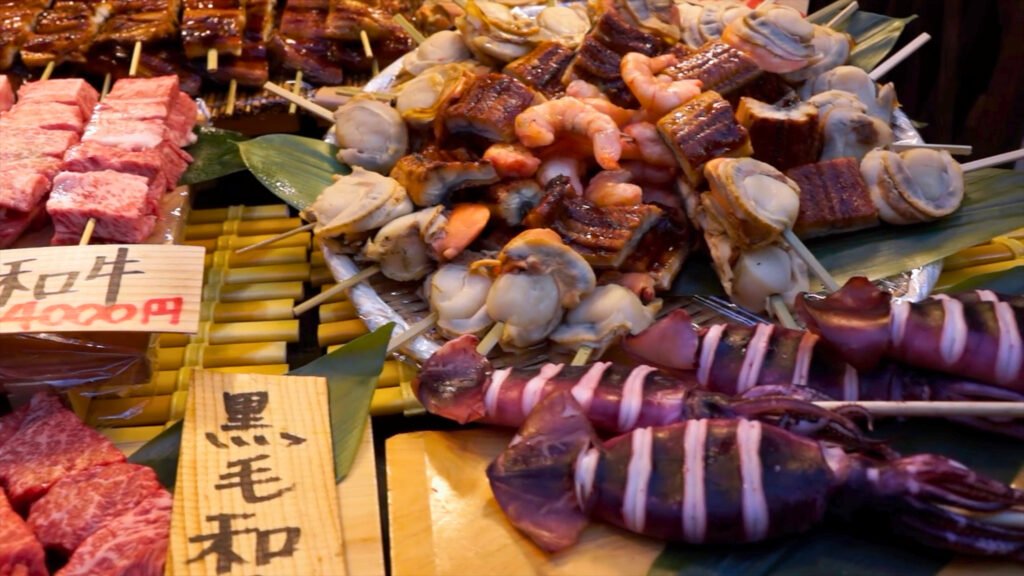
Start your morning at Tsukiji Outer Market, the famous seafood market where Tokyo’s best sushi chefs source their ingredients. While the inner wholesale market moved to Toyosu, the outer market remains a bustling hub of fresh seafood, street food, and culinary experiences.
Wander through the alleys and sample some of the must-try delicacies:
- Fresh Sushi: Try an omakase (chef’s choice) sushi breakfast at popular restaurants like Sushizanmai or Sushi Daiwa.
- Grilled Seafood: Enjoy freshly grilled scallops, oysters, or eel skewers from street vendors.
- Tamagoyaki (Japanese Omelet): Sweet and savory, this fluffy omelet is a staple at Tsukiji.
- Matcha & Japanese Sweets: Stop by a traditional sweet shop to try dorayaki (red bean pancakes) or matcha-flavored treats.
For those who want a hands-on experience, consider booking a sushi-making class near Tsukiji to learn the art of crafting sushi from expert chefs.
A short walk from Tsukiji Market brings you to Hamarikyu Gardens, a beautiful Edo-period garden that offers a peaceful retreat from the city’s hustle and bustle. A highlight of your visit is the Nakajima-no-Ochaya Tea House, where you can experience an authentic Japanese tea ceremony. Enjoy a bowl of matcha tea paired with a delicate wagashi (Japanese sweet).
Afternoon: Ginza Shopping & Cultural Experiences
Next, head to Ginza, Tokyo’s upscale shopping and entertainment district. Known for its luxury boutiques, high-end department stores, and stylish architecture, Ginza is a paradise for shoppers and culture lovers alike.
Some must-visit places in Ginza include:
- Ginza Six: A premier shopping complex featuring designer brands, a rooftop garden, and an impressive art gallery.
- Mitsukoshi Department Store: Tokyo’s oldest department store, offering high-end fashion, gourmet food halls, and elegant gift items.
- UNIQLO Ginza: The flagship store of Japan’s popular fashion retailer, spanning 12 floors of stylish yet affordable clothing.
- Itoya Stationery Store: A paradise for stationery lovers, featuring exquisite Japanese paper, fountain pens, and art supplies.
For an artsy experience, visit the Ginza Graphic Gallery or explore contemporary Japanese art at the Shiseido Gallery.
Evening: Fine Dining in Ginza
End your day with an unforgettable dining experience in Ginza. This district is home to some of the best restaurants in the world, ranging from Michelin-starred sushi spots to elegant kaiseki (multi-course) dining.
Here are a few top dining options:
- Sukiyabashi Jiro: The legendary sushi restaurant run by Jiro Ono, featured in the documentary Jiro Dreams of Sushi.
- Ginza Kojyu: A renowned kaiseki restaurant offering seasonal Japanese delicacies in an intimate setting.
- Tempura Kondo: A Michelin-starred restaurant specializing in delicate, crispy tempura.
- Ginza Steak: For those craving Wagyu beef, this teppanyaki-style steakhouse serves some of the finest cuts of meat in Tokyo.
If you prefer a more casual yet refined experience, visit Ginza Lion, Tokyo’s oldest beer hall, known for its lively atmosphere and German-style draft beer.
Night Stroll and Illuminations
Before heading back to your hotel, take a leisurely evening stroll along Chuo-dori Avenue, Ginza’s main shopping street. At night, the area is beautifully illuminated, with department stores and luxury boutiques glowing under the city lights.
For a breathtaking view, visit the Rooftop Garden at Ginza Six, where you can enjoy panoramic vistas of Tokyo’s skyline in a tranquil setting.
Day 7: Tokyo Bay and Odaiba
Your final day in Tokyo is dedicated to the stunning waterfront district of Odaiba, a man-made island in Tokyo Bay that boasts futuristic architecture, interactive museums, relaxing parks, and breathtaking city views.
Morning: Sumida River Cruise to Odaiba and teamLab Borderless Museum
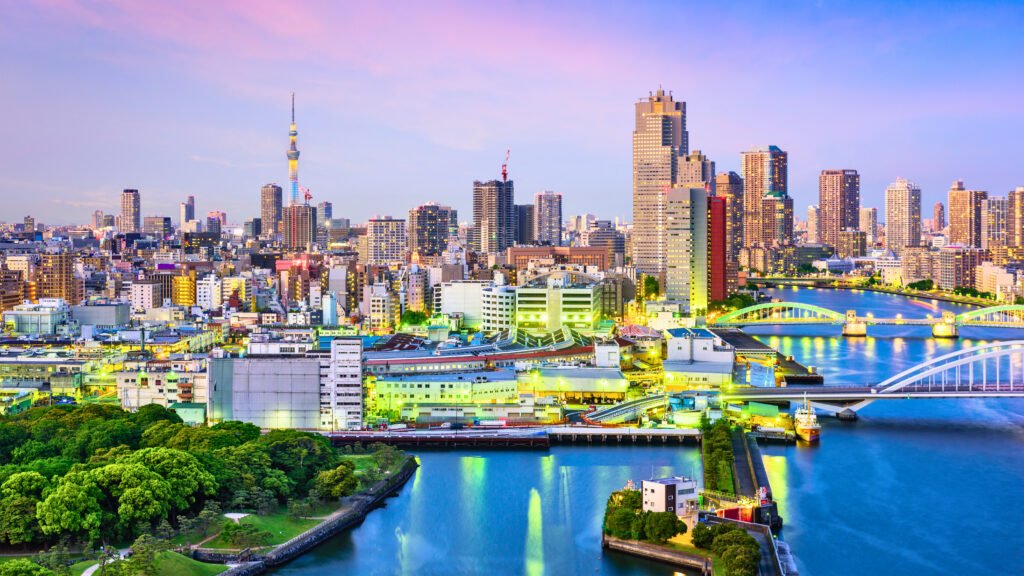
Start your day with a scenic cruise along the Sumida River, traveling from Asakusa to Odaiba. The boat ride provides a different perspective of Tokyo, passing under iconic bridges and offering great views of the city’s skyline. You can take a Himiko or Hotaluna ferry, designed by anime legend Leiji Matsumoto, for a stylish and comfortable ride.
Upon arrival in Odaiba, visit teamLab Borderless, one of Tokyo’s most mesmerizing digital art museums. This immersive space features ever-changing exhibits where light, sound, and movement create an interactive dreamscape. The museum is an unforgettable experience and perfect for photography enthusiasts looking to capture unique moments.
Afternoon: Exploring Odaiba’s Attractions
Odaiba is home to several exciting attractions, and you can tailor your visit based on your interests:
- DiverCity Tokyo Plaza: Visit this shopping mall to see the life-sized Unicorn Gundam statue, which performs light shows throughout the day. Inside, you’ll find a variety of Japanese fashion brands, souvenirs, and food courts.
- Miraikan (National Museum of Emerging Science and Innovation): Science and tech enthusiasts will love this museum, which features exhibits on robotics, space exploration, and artificial intelligence. You can even meet ASIMO, Honda’s famous humanoid robot.
- Toyota Mega Web: Car lovers can explore futuristic Toyota concept cars and even test drive some of them at this interactive showroom.
- VenusFort: A unique European-style shopping mall with an indoor sky ceiling that mimics different times of the day, perfect for those looking to do some last-minute souvenir shopping.
For a relaxing end to your afternoon, head to Odaiba Seaside Park, a tranquil area with sandy shores where you can enjoy stunning views of the Rainbow Bridge and Tokyo Tower in the distance. You can also rent a bicycle and take a ride along the waterfront promenade.
If you’re up for a little adventure, consider visiting the Oedo Onsen Monogatari, a traditional hot spring theme park where you can enjoy an authentic onsen (Japanese bathhouse) experience, complete with yukata rentals and Edo-era street food stalls.
Evening: Tokyo Skytree and Farewell Dinner
End your trip with a visit to Tokyo Skytree, the tallest structure in Japan, where you can witness Tokyo’s glittering skyline at night.
As your Tokyo journey comes to a close, consider enjoying a memorable farewell dinner at one of the tower’s restaurants. Book a table at a rooftop restaurant such as Bills Odaiba (famous for their fluffy pancakes and scenic views) or The Grill on 30th at Grand Nikko Tokyo, offering exquisite cuisine with a stunning backdrop of Tokyo Bay.
Alternatively, for a unique experience, take a Yakatabune Dinner Cruise, a traditional Japanese boat cruise offering delicious kaiseki meals while floating past Rainbow Bridge and Tokyo Bay.
Local Food Recommendations
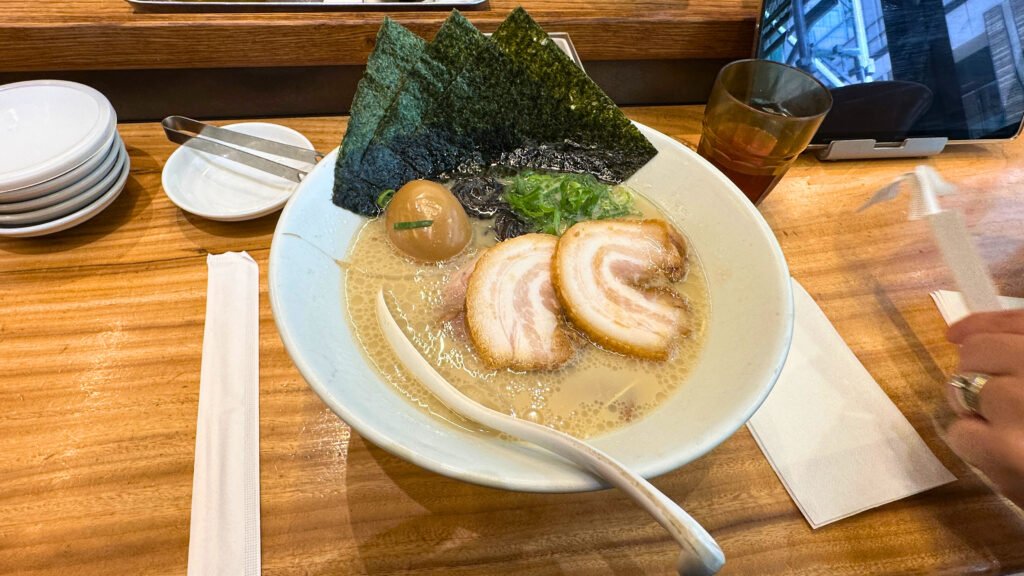
Iconic Dishes to Try:
- Sushi at Tsukiji Outer Market or a conveyor belt sushi restaurant.
- Ramen from specialty shops like Ichiran or Ippudo.
- Tempura from traditional eateries like Tenmatsu.
- Okonomiyaki (Japanese savory pancakes) in Asakusa.
Street Food Favorites:
- Takoyaki (octopus balls) from Ameya-Yokocho.
- Taiyaki (fish-shaped pastry with red bean filling).
- Crepes from Takeshita Street in Harajuku.
Dining Tips:
- Look for izakayas for a casual and authentic dining experience.
- Many restaurants display plastic food replicas to make ordering easier.
- Vegetarian options are limited, so plan ahead if you have dietary restrictions.
Best Times to Visit Tokyo
Tokyo is a year-round destination, with each season offering unique experiences, weather conditions, and cultural events. When planning your visit, consider what type of experience you want—whether it’s viewing cherry blossoms, enjoying traditional festivals, or exploring the city with fewer crowds. Here’s a breakdown of the best times to visit Tokyo:
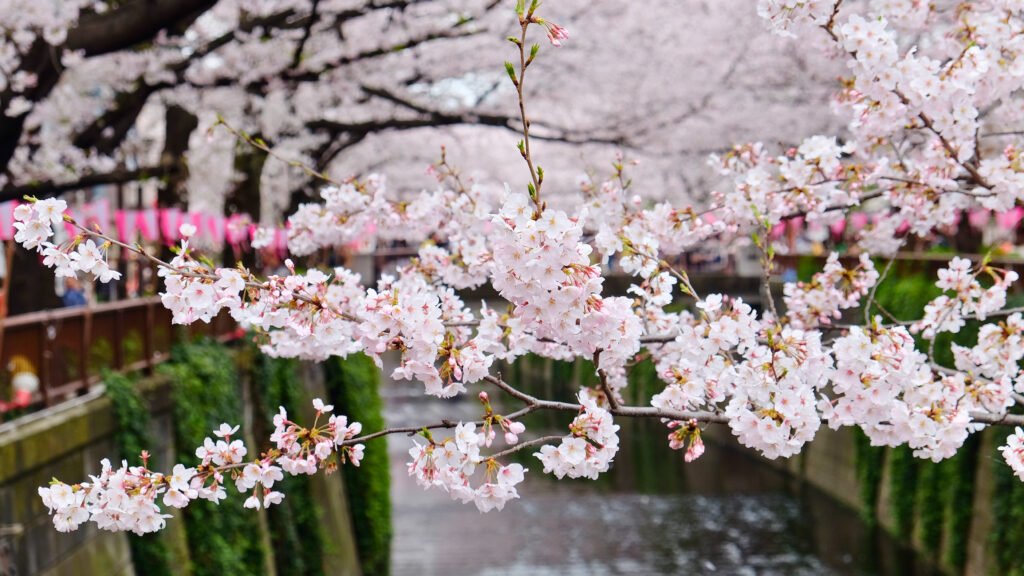
Spring (March to May) – Cherry Blossoms and Pleasant Weather
Spring is one of the most popular seasons to visit Tokyo, thanks to its mild temperatures and the breathtaking sakura (cherry blossoms) that blanket the city in pink and white hues.
- Weather: Daytime temperatures range from 10°C to 20°C (50°F to 68°F), making it ideal for outdoor exploration.
- Key Events:
- Cherry Blossom Festivals: Parks like Ueno Park, Shinjuku Gyoen, and Chidorigafuchi become prime spots for hanami (flower viewing picnics) in late March to early April.
- Sanja Matsuri (May): One of Tokyo’s most lively Shinto festivals, held at Asakusa’s Senso-ji Temple.
- Why Visit?
- Enjoy the breathtaking cherry blossoms, picnics, and mild weather perfect for walking tours.
- Spring is also a great time for seasonal delicacies like sakura mochi (sweet pink rice cakes wrapped in cherry leaves).
- Downside:
- Higher accommodation prices and larger crowds due to the popularity of cherry blossom season.
Summer (June to August) – Festivals and Fireworks
Summer in Tokyo is hot, humid, and lively, with an abundance of matsuri (festivals) and impressive fireworks displays.
- Weather: Temperatures can soar up to 35°C (95°F) with high humidity levels, making it feel even warmer.
- Key Events:
- Sumida River Fireworks Festival (July): One of Tokyo’s most famous fireworks shows, drawing massive crowds.
- Tanabata Festival (July): Celebrates the legendary meeting of two celestial lovers, with decorations and traditional performances.
- Obon Festival (August): A Buddhist festival honoring ancestors, featuring lantern-lit celebrations and Bon Odori (folk dance).
- Why Visit?
- Experience lively summer festivals with traditional yukatas, street food, and fireworks displays.
- Explore seasonal beer gardens and rooftop dining with stunning night views.
- Visit Tokyo’s coastal getaways like Enoshima or take a day trip to Mt. Fuji’s 5th station.
- Downside:
- Extremely high humidity and frequent afternoon showers.
- Crowds at popular summer festivals.
Autumn (September to November) – Fall Foliage and Comfortable Temperatures
Autumn is one of the best seasons to visit Tokyo, with mild temperatures and stunning autumn foliage coloring the city’s parks and temple grounds.
- Weather: Comfortable temperatures ranging from 12°C to 22°C (54°F to 72°F).
- Key Events:
- Meiji Jingu Gaien Ginkgo Festival (November): Famous for its golden ginkgo trees lining the main avenue.
- Tokyo Ramen Show (October-November): A must-visit for ramen lovers, featuring stalls from Japan’s best ramen shops.
- Why Visit?
- Enjoy crisp autumn air and less humidity compared to summer.
- Spectacular foliage at Rikugien Garden, Yoyogi Park, and Mount Takao.
- Ideal season for outdoor activities like hiking and biking.
- Downside:
- Occasional typhoons in September, though they are usually short-lived.
Winter (December to February) – Illuminations and Fewer Crowds
Winter in Tokyo is relatively mild compared to other parts of Japan, with clear skies and beautiful winter illuminations throughout the city.
- Weather: Average temperatures range from 2°C to 12°C (36°F to 54°F). Snowfall is rare but possible.
- Key Events:
- Christmas Illuminations (December): Tokyo’s streets, shopping districts, and landmarks glow with dazzling lights.
- New Year’s Celebrations (January 1): Join locals for hatsumode (first shrine visit of the year) at Meiji Shrine.
- Setsubun (February): A bean-throwing festival to ward off evil spirits.
- Why Visit?
- Fewer tourists, making it a great time to visit popular attractions without the crowds.
- Enjoy seasonal winter foods like nabe (hot pot), oden (stewed fish cakes), and yakiimo (roasted sweet potatoes).
- Great time for a day trip to Nikko or Hakone, where you can experience onsen (hot springs) with a winter backdrop.
- Downside:
- Some outdoor attractions close earlier due to shorter daylight hours.
Cultural Experiences Unique to Tokyo
Traditional Tea Ceremony (Year-round)
- Experience the art of Japanese tea preparation at places like Hamarikyu Gardens, Happo-en, or Meiji Shrine’s tea house.
- Learn about the significance of matcha, the etiquette of tea drinking, and the philosophy of Zen simplicity.
Kabuki Theater at Kabukiza (Year-round)
- Watch traditional Kabuki performances at Kabukiza Theater in Ginza, showcasing elaborate costumes and dramatic storytelling.
- Single-act tickets are available for those who are short on time but eager to witness this unique art form.
Sumo Wrestling Tournaments (January, May, September)
- Held at Ryogoku Kokugikan, these tournaments provide an up-close look at Japan’s national sport.
- Visitors can also explore the Sumo Museum and try the sumo wrestler’s favorite meal, Chanko Nabe (hot pot).
Visit a Sumo Stable (Year-round, by appointment)
- Watch early morning sumo training at one of the stables in Ryogoku.
- A rare chance to witness the discipline and rituals of sumo wrestlers up close.
Samurai & Ninja Experiences (Year-round)
- Participate in a samurai sword-fighting lesson at places like Samurai Museum in Shinjuku.
- Learn ninja techniques at Ninja Experience Café.
Wear a Kimono in Asakusa (Year-round)
- Rent a kimono and stroll through Asakusa, Meiji Shrine, or traditional gardens for an immersive cultural experience.
- Many rental shops offer hairstyling and photography services.
Travel Tips for First-Time Visitors
Tokyo is an exciting city, but navigating it for the first time can feel overwhelming. These travel tips will help ensure a smooth and enjoyable experience in Japan’s bustling capital.
Transportation:
- Get a Suica or Pasmo Card: These IC cards make riding trains, subways, and buses easy. Simply tap and go without worrying about buying individual tickets.
- Use Google Maps or HyperDia: These apps help with route planning, train schedules, and estimated travel times.
- JR Pass for Regional Travel: If you plan to visit Kyoto or other cities, a Japan Rail Pass can save money on long-distance trains.
- Avoid Rush Hours: Tokyo’s trains get extremely crowded between 7:30 AM – 9:00 AM and 5:30 PM – 7:30 PM. Travel outside these hours for a more comfortable experience.
- Take the Yamanote Line: This circular train route connects many major tourist areas like Shinjuku, Shibuya, Akihabara, and Ueno.
Language & Communication
- Basic Japanese Phrases Help: Learning a few phrases like “Arigato” (Thank you) and “Sumimasen” (Excuse me) can be useful.
- Google Translate & Voice Apps: These can help with menus, signs, and simple conversations.
- English Signage: Many train stations, major attractions, and hotels have English signs, making navigation easier.
Cultural Etiquette & Manners
- Bowing is Common: A slight bow is a polite greeting and shows respect.
- Quiet in Public Transport: Avoid talking loudly on trains and buses. Using phones for calls is discouraged.
- Remove Shoes Indoors: Always remove shoes before entering temples, traditional inns (ryokan), or someone’s home.
- Line Up Properly: Whether waiting for a train, elevator, or store checkout, Japanese people form orderly lines.
- Avoid Eating While Walking: Eating on the go is considered rude in Japan. Find a bench or designated eating area.
- Use Both Hands When Giving/Receiving Items: Whether it’s money, a business card, or a souvenir, using both hands is a sign of politeness.
Money & Budgeting:
- Take advantage of free attractions like parks and temples.
- Try Convenience Store Food: 7-Eleven, Lawson, and FamilyMart offer surprisingly delicious and affordable meals like sushi, bento boxes, and onigiri (rice balls).
- Tipping is Not Expected: Service charges are included in bills, and leaving a tip can sometimes confuse staff.
- Cash is Still Common: Many smaller shops, local restaurants, and street vendors prefer cash, so always carry some yen.
- ATMs at Convenience Stores: 7-Eleven, FamilyMart, and post offices have international ATMs that accept foreign cards.
- Tax-Free Shopping: Many stores offer tax-free shopping for tourists. Bring your passport and shop at participating stores like Don Quijote, Uniqlo, and Bic Camera.
Conclusion
Your 7-day Tokyo adventure has come to an end, but the memories and experiences you’ve gained will last a lifetime. From exploring ancient temples and futuristic skyscrapers to indulging in world-class cuisine and immersing yourself in vibrant cultural traditions, Tokyo has provided a journey unlike any other.
This itinerary was designed to give first-time visitors the perfect balance of sightseeing, cultural immersion, and relaxation. Whether you strolled through the historic streets of Asakusa, admired the neon lights of Shinjuku, soaked in an onsen in Hakone, or tasted the freshest sushi at Tsukiji Outer Market, you’ve now experienced the very best of Tokyo.
However, Tokyo is a city that never stops evolving. Even after spending a week here, you’ve only scratched the surface of what this incredible metropolis has to offer. From hidden alleyways filled with tiny izakayas to serene temple gardens tucked away from the crowds, Tokyo holds countless secrets waiting to be discovered on your next visit.
Final Takeaways for Your Trip:
- Embrace the culture: Respect local customs, whether it’s removing your shoes before entering a home or bowing when greeting someone.
- Be adventurous with food: Don’t hesitate to try new dishes, from conveyor belt sushi to street food like takoyaki and taiyaki.
- Use Tokyo’s efficient transport: Get a Suica or Pasmo card to easily navigate the city’s vast train and subway system.
- Plan for seasonal beauty: Consider visiting Tokyo during cherry blossom season in spring or for the spectacular autumn foliage in fall.
- Take day trips: Extend your adventure by visiting nearby gems like Nikko, Kamakura, or Mount Fuji.
Most importantly, enjoy every moment. Tokyo is a city that thrives on energy, innovation, and deep-rooted traditions. Whether you were mesmerized by the bustling atmosphere of Shibuya Crossing, the quiet charm of a hidden shrine, or the dazzling skyline from Tokyo Skytree, you’ve now become part of this ever-evolving story.
Would you visit Tokyo again? What was your favorite part of this itinerary? Let us know in the comments, and don’t forget to share this guide with fellow travelers planning their first trip to Japan! For more insights and detailed travel tips, visit the Tokyo tourism website.
Arigato gozaimasu! ありがとう ございます! Safe travels, and see you again in Tokyo! 🇯🇵✨

For more travel guides on Japan and Asia, check out our posts:
- Best Places To Visit In Japan: Your Ultimate Guide To The Top 15 Must-See Destinations
- Best Places To Visit In Asia: Top 10 Must-See Destinations
- 15 Best Places To Visit In Southeast Asia: A Traveler’s Ultimate Guide
- Best Places To Visit In Malaysia: Top 15 Must-See Destinations For First-Time Travelers
- 15 Best Places To Visit In Sri Lanka: A Complete Travel Guide To Top Destinations
- Best Places To Visit In Thailand: Top 15 Unmissable Destinations, Travel Tips & Local Gems
- Best Places To Visit In Vietnam: 15 Must-See Destinations For An Unforgettable Journey
Trending Travel Destinations
- 15 Best Places To Visit In Portugal: A Complete Guide To Top Destinations, Attractions & Local Insights
- 15 Best Places To Visit In Greece: Discover Iconic Landmarks, Hidden Gems, And Local Favorites
- Best Places To Visit In Italy: Top 15 Must-See Destinations
- The 15 Best Places To Visit In Canada: Your Ultimate Guide To Canada’s Must-See Destinations
- Best Places To Visit In USA: Top 15 Must-See Destinations And Travel Guide For Every Season
Don’t forget to follow us on YouTube, Instagram, Facebook, and Twitter for more travel tips and inspiration.
If this post was helpful, check out our blog for more travel guides and tips!

